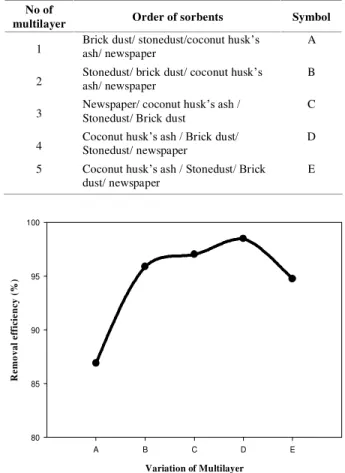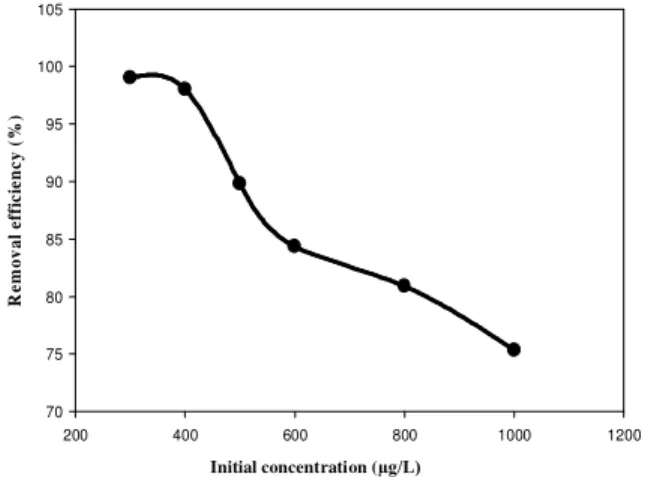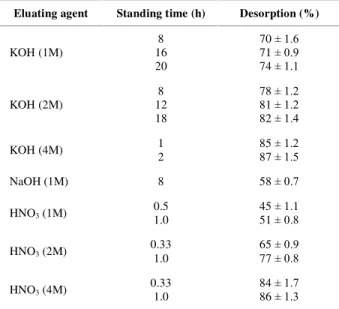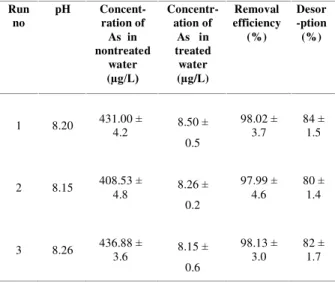Pak. J. Anal. Environ. Chem. Vol. 11, No. 1 (2010) 28–35
Removal of Arsenic from Groundwater with Low Cost
Multilayer Media
Abdus Samad, Mohammad Arifur Rahman
and A. M. Shafiqul Alam*
Department of Chemistry, University of Dhaka, Dhaka-1000, Bangladesh---
Abstract
A simple, low cost arsenic removal system was developed to treat arsenic contaminated ground water containing 425 ± 4.2 µg/L arsenic. The system decontaminates arsenic from water by
sorption through fine particles of waste materials (Coconut husk’s ash, Refused brick dust, Stone
dust and Waste newspaper) of multilayer. The treatment efficiency of the process was investigated under various operating conditions that might affect the sorption/ desorption of arsenic. Sorption column method shows the optimum removal of As(III) under the following conditions: initial As concentration (100 µg/L), sorbent amount (4.0 g for brick dust, 3.0 g for stone dust, 3.0 g for Coconut husk’s ash and 0.3 g for waste newspaper), particle size (<355µm), treatment flow rate
(1.4 mL/min), optimum volume (100 mL) and pH (5.0). Desorption efficiencies with 2M of KOH after the treatment of groundwater were observed in the range of 78 ± 1.2% - 82 ± 1.4%. Average
arsenic concentration of treated sample water was 8.30 ± 0.4 µg/L which is below the WHO
guideline value for Bangladesh. Different techniques were used to measure thirteen metals, four anions with pH, conductivity, and temperature to understand the status of other species before and after treatment. The average concentrations of other inorganic constituents of health concern (Cu, Mn, Pb, Cr and Fe) in treated water were below WHO guideline value for drinking water. The present study showed a new method for removal of as from ground water.
Keywords: Arsenic; Removal; Sorption; Low cost; Multilayer.
--- Introduction
Arsenic pollution is one of the serious water contaminations of drinking water. It is a ubiquitous
element which ranked 20th in natural abundance,
comprising about 0.00005% of earth crust, 14th in
sea water and 12th in human body [1].It is found in
the atmosphere, soils, rocks and natural organisms. Natural processes including soil erosion, mineral leaching and weathering are responsible for introducing arsenic into surface waters [2]. Soil
erosion and leaching contribute to 612 x 108 g/year
and 2380 x 108 g/year of arsenic respectively, in
dissolved and suspended forms in the ocean.
Arsenic occurs as organic and inorganic
compounds in natural water. It is found that arsenic toxicity depends on its oxidation state. Arsenites As(III) are ten times more toxic for biological systems than arsenates. The inorganic forms of
arsenic are more toxic than organic-arsenic compounds.
The prolonged exposure of humans to nonlethal arsenic dose causes chronic health effects, but long time exposure usually causes death. The arsenic calamity of Bangladesh can be described as the largest known mass poisoning in
the history, with an estimated 35–77 million people
exposed to arsenic-contaminated drinking water [3]. About 61% of the tube wells water has arsenic content above 0.05 mg/L and about
13% have arsenic content above 10µg/L [4].
This is significantly higher than the World Health Organization (WHO) maximum permissible
limit in drinking water (50µg/L). The
Environmental Protection Agency (EPA) has
recently adjusted the upper limit of arsenic 10µg/L in drinking water.
Arsenic can be removed from aqueous solution by using many technologies such as ion exchange resin, activated alumina, coprecipitation with iron or alum, reverse osmosis, membrane filtration, modified coagulation/filtration, and enhanced lime softening etc [5-8]. However, none of these technologies are currently applied on a
broad scale in developing countries like
Bangladesh as they require sophisticated technical systems and are therefore unpractical in low income regions. Among these methods, the adsorption techniques are simple and convenient for regeneration and sludge free operation. So far, various adsorbents for arsenic removal have been developed that include materials such as metal-loaded coral limestone [14], hematite and feldspar [16] activated carbon and activated alumina [15], hydrous zirconium oxide, rice husk [9] sawdust and oyster shell [13]. However, most of these adsorbents entail several problems in terms of efficiency and cost [9].
The present work was aimed to develop a cost effective and simple method for arsenic decontamination from drinking water. Various chemical parameters in water before and after treatment were measured. The sorbents used in these experiments were waste materials. They were available and cheap. They were found to have tremendous arsenic uptake capacity.
Experimental Reagents
All reagents used throughout this work were of analytical-grade purity. Arsenic (III) standard solution of 1000 mg/L was procured from Kanto Company, Japan and NaOH, KOH, HCl,
HNO3, and H2SO4 were obtained from Merck,
Germany. Stock solution (10 mg/L) of As(III) was prepared in de-ionized water from Arsenic(III) standard solution of 1000 mg/L. Dilute standard solutions were freshly prepared.
Preparation of sorbents
Four types of sorbents were used. These
were coconut husk’s ash, refused brick dust, stone
dust and used newspaper. The newspaper used in the present work was obtained from a university dormitory which contains large amount of
cellulose. Coconut husk’s ash was collected from
Darichar Luxmipur village of Madaripur district. Stone dust and Refused brick were collected from respective sites of Dhaka city. Sorbents were washed by water several times to remove dust and fine particles. The washed materials were then dried in a hot-air oven (NDO-450ND, EYELA,
Japan) at 110° C for 24 hours. The washed dried
materials were grinded and sieved into the
following three size fractions (600-425) µm,
(425-355) µm and <355 µm. Coconut husk’s ash
was dried only and its particle size was only <355 µm. Newspaper was shredded into small pieces and then dried. Before using into column, it was soaked with water for 24 hours and then shredded again to make into paste like substance and finally washed with water three times to make ink free. All materials were used for the removal of arsenic without any chemical pretreatment. To make a multilayer, firstly the particle sizes and amount of sorbents were optimized. Each sorbent of optimized amount was placed in the column and water was passed through it to remove dust and dissolved substances. Similarly other sorbents were added successively.
Arsenic removal experiment in column
For individual treatment, all sorbents except newspaper, (2.0~6.0) g were added to the treatment glass column (2.5 cm x 30 cm). Newspaper was added (0.1~0.5) g. Sorption experiments were carried out in a column that was equipped with a stopper for controlling the column effluent flow rate (treatment rate). Sorption factors including the amount of sorbents (0.1-6.0) g,
particle size (<355-600) µm, treatment flow rate
(1.0-2.2) mL/min, initial As concentration
(300-1000) µg/L, and pH (1-12) were evaluated. The
packing density of refused brick dust
(<355µm) was 0.96 g/cm3, Stone dust (<355µm)
was 1.25 g/cm3, Coconut husk’s ash was 0.58
g/cm3 and waste news paper was 0.36 g/cm3.
Small amount of glass wool was inserted into the bottom of the column to prevent the loss of
sorbents during the treatment. The flow
rate was kept constant by controlling
efficiency was calculated by using the following equation:
Removal (sorption) efficiency = [(C0-Ce) / C0]x100
Where, C0 and Ce are the concentration of As in
the sample solution before and after treatment, respectively.
Analysis of arsenic
The treated and nontreated sample solutions were analyzed using Hydride Vapor
Generator (HVG) attached with Atomic
Absorption Spectrophotometer (AAS-680,
Shimadzu, Japan) for the determination of total arsenic followed by the generation of arsine gas
(AsH3).
Sodium borohydride solution
3.0 g of sodium hydroxide and 2.5 g of sodium borohydride (both were analar grade) were dissolved in distilled deionized water and finally volume of the solution was adjusted to 500 mL by adding deionized water.
Hydrochloric acid solution
Concentrated hydrochloric acid (37%, analar grade) was diluted to make 500 mL of 5M HCl.
Preparation of standard arsenic solution
From 10 mg/L stock solution, 1-5 µg/L,
100 mL of As3+ solutions were prepared. The
standard solutions were aspirated in HVG – AAS
and a calibration curve was prepared.
Analysis of samples
The treated samples were diluted to a known volume after adding 2.0 g of KI and 2.0 ml of concentrated HCl in each of the sample solutions. Samples were then allowed to stand for two hours and were analyzed by HVG-AAS [10]. The samples were analyzed against a calibration curve prepared by the standard solutions of arsenic. Each unknown sample was analyzed three times.
Analysis of Na, K, Ca, Mg, Cu, Mn, Cr, Pb and Fe
Na, K, Ca, Mg, Cu, Mn, Cr, Pb and Fe were analyzed using Flame Atomic Absorption Spectrophotometer. (Model: AA-680, Shimadzu, Japan) [10]. Precision and analytical accuracy of the methods were evaluated by standard reference material, Wheat flour, SRM 8437 (National Institute of Standard and Technology, USA).
Analysis of Cl-, PO43-, NO3- and SO4
2-Cl-, PO4
3-, NO3
-
and SO4
from the treated and untreated samples were analyzed by UV-visible spectrophotometric method [10].
Results and Discussion
Initially four different sorbents were selected and arsenic solution of 100 mL (pH~6.7)
and 100 µg/L was passed through 5.0 g of each
sorbent and removal efficiency was evaluated.
Removal efficiency of coconut husk’s ash was 94.8
± 0.6%, stone dust 88.50 ± 0.8%, for brick dust
84.72 ± 1.2%. The performances of sorbents were
evaluated for the removal of As (III). Preliminary studies showed that the complete removal of As(III) was achieved under the following
conditions: particle size <355 µm, amount of
coconut husk’s ash, 3.0 g; stone dust, 4.0 g; brick
dust 4.0 g and newspaper 0.3 g.
Effect of particle size
Column sorption experiments were carried out for the removal of As(III) from aqueous solution using three different particle sizes
[<355µm, (355-425) µm and (425-600) µm] with
the constant amount of sorbents (5.0g) of both stone dust and brick dust. Removal efficiency of arsenic was found decreased with increasing particle size. As the size of the sorbent particles increased, the sorption of metal ions decreased. Lower particle size provides higher surface area for arsenic to be accumulated.
Effect of the amount of sorbents
Variation of Multilayer
A B C D E
R
e
m
o
v
a
l
e
ff
ic
ie
n
cy
(
%
)
80 85 90 95 100
0 1 2 3 4 5 6 7
R
e
m
o
v
a
l
e
ff
e
c
ie
n
c
y
(
%
)
0 20 40 60 80 100 120
Amount of sorbent (g)
0.0 0.1 0.2 0.3 0.4 0.5 0.6
Coconut husk's ash Stone dust Brick dust Newspaper
Scale 0.0-0.6g for the amount of newspaper
were presented in (Fig. 1). For all sorbents
(coconut husk’s ash, stone dust, brick dust and
newspaper) removal efficiencies of As(III) were increased gradually with the increase of amount of sorbents up to a certain level. Then removal
efficiency was not changed significantly. Sorbent’s
sorption capacity was depended on the surface activity such that specific surface area available for As-surface interactions that was accessible to the As(III). At higher amount of sorbent, surface area was decreasd due to agglomeration of the same sorbent particles. Considering the removal efficiencies of the sorbents, 4.0 g of both stone
dust and refused brick, 3.0 g of coconut husk’s ash
and 0.3 g of newspaper were chosen for next study.
Figure 1. Effect of sorbent’s amount on the removal of As(III) by adsorption onto Coconut husk’s ash, stone dust, brick dust, newspaper.
Initial concentration of Arsenic solution, 100 µg/L Volume of sorbate solution, 100 mL
Flow rate, 0.6 mL/min
Formation of multilayer
By using these optimized amounts of different sorbents a multilayer was prepared. Order of sorbents was chosen arbitrarily. The different multilayer were assigned by block letters (A, B, C, D and E) and presented in Table 1. Arsenic
solution of concentration 400 µg/L and volume
100 mL was passed through each column. Results were represented in (Fig. 2). It shows that
multilayer ‘D’ has the highest arsenic removal
efficiency which was 98.48%. It was notable that when arsenic solution was treated individually with sorbent, the average removal efficiency of
optimized amount of sorbents was about 90 ±
1.2%. However, multilayer showed 98.48 ± 1.6%
removal efficiency. Therefore, the removal efficiency was improved due to the formation of multilayer. It was due to the availability of fresh active sites in multilayer where arsenic was
adsorbed successively. In multilayer D, coconut
husk’s ash was at the bottom layer which had highest removal efficiency, made possible to remove the remaining arsenic effectively.
Table 1. Order of sorbents in multilayer (Bottom layer to top layer).
No of
multilayer Order of sorbents Symbol
1 Brick dust/ stonedust/coconut huskash/ newspaper ’s A
2 Stonedust/ brick dust/ coconut huskash/ newspaper ’s B
3 Newspaper/ coconut huskStonedust/ Brick dust ’s ash / C
4 Coconut huskStonedust/ newspaper ’s ash / Brick dust/ D
5 Coconut husk’s ash / Stonedust/ Brick dust/ newspaper
E
Figure 2. Comparison of relative removal efficiency of various Multilayer.
Initial conc. of Arsenic solution, 400 µg/L
Volume of sorbate solution, 100 mL Particle size, <355 µm
Flow rate, 0.6 mL/min
Inintial concentration (
200 400 600 800 1000 1200
R
e
m
o
v
a
l
e
ff
ic
ie
n
c
y
(
%
)
70 75 80 85 90 95 100 105
Initial volume (mL)
40 60 80 100 120 140 160 180 200 220
R
em
o
v
a
l
e
ff
ic
ie
n
cy
(
%
)
50 60 70 80 90 100 110 Effect of flow rate
The effect of flow rate on the removal of
As(III) was examined. It was observed that removal efficiency decreased with increasing flow
rate. Removal efficiency varied from 98 ± 0.8 % to
91 ± 1.1 % with increasing flow rate from 1.0 mL/min to 2.2 mL/min. When the flow rate was slow, As(III) in the sample solution got more contact time with the active surface of the sorbents in the multilayer. So, the probability of interactions was higher.
Effect of initial concentration
For the evaluation of the effect of initial concentration, 100 mL solution of various concentrations of As(III) was treated onto the multilayer. The results were illustrated in (Fig. 3) which showed that removal efficiency decreased with increasing initial concentrations. The removal
efficiency of Arsenic decreased from 99 ± 2.0 % to
75 ± 0.6 % with the increase of initial
concentration from 300µg /L to 1000 µg /L. At
low concentration, most of the As(III) in the solution got enough active sites of sorbent but with increase of concentration, all As(III) species were not able to come in contact with active sites of sorbents.
Figure 3. Effect of initial sorbate concentration on the removal of As(III) by sorption onto Multilayer.
Volume of Arsenic solution, 100 mL Flow rate, 1.4mL/min
Particle size, <355 µm
Multilayer, D (Coconut husk’s ash / Brick dust/ Stone dust/ newspaper)
Effect of initial volume
Different initial volumes with optimized
concentration 400 µg/L As(III) solution were
treated onto multilayer and results were
summarized in (Fig. 4). It shows clearly that removal efficiency decreases with increase of initial volume. The removal efficiency varied from 99 ± 1.7 to 59 ± 0.3 % with initial volume 50 mL to 200 mL. This removal efficiency was decreased due to the less availability of active sites to get contact of multilayer. Less volume of solution contains less amount of arsenic; as a result most of arsenic got available sorbent sites.
Figure 4. Effect of sorbate volume on the removal of As(III) by sorption onto Multilayer.
Initial concentration of Arsenic solution, 400 µg/L Flow rate, 1.4 mL/min
Particle size, <355 µm
Multilayer, D (Coconut husk’s ash / Brick dust/ Stone dust/ newspaper)
Effect of pH
pH is one of the most important parameters controlling the metal ion sorption process [11]. The pH will determine whether the ionized or unionized sorbate species will exist in solution as well as the degree of ionization of surface functional groups. Sorption experiments were carried out at different pH (1-12) and (Fig. 5) described the effect of pH on As(III) removal with sorbent. The efficiency curve was a hump shape. Highest removal efficiency was found
at pH 5. It is due to the existence of H2AsO4
-species at this pH, which is suitable for adsorption rather than neutral species. Moreover, waste newspaper, alumina and iron oxide have greater
pH
0 2 4 6 8 10 12 14
R
e
m
o
v
a
l
e
ff
ic
ie
n
c
y
(
%
)
0 20 40 60 80 100 120
accumulation capacity at this pH due to the
formation of C-OH2
+
, AlOOH and FeOOH species which act as potential arsenic sorbent sites [12].
Figure 5. Effect of pH on the removal of As(III) by sorption onto Multilayer.
Initial concentration of Arsenic solution, 400 µg/L Volume of Arsenic solution, 100 mL
Flow rate, 1.4 mL/min
Multilayer, D (Coconut husk’s ash/Brick dust/Stone dust/ newspaper)
Desorption
In order to recover arsenic from sorbents for its safe disposal as well as keeping the process cost low, the possibility of desorption in many cases is as important as sorption. Desorption experiments were carried out at different concentration of acids and bases and were presented in Table 2. Attempts were made to desorb As(III) from the sorbents surface with various eluents, such as HCl,
HNO3, NaOH and KOH. This desorption
process was performed using the batch
method. Desorption efficiency of arsenic
tends to increase with increasing standing time. Acid desorption was problematic because it
degraded the sorbents used for sorption.
Potassium hydroxide solution was useful for the desorption of arsenic from the surface of
sorbents. In both acidic and basic
conditions, highest desorption was achieved from 86 to 87% rather than 100%. It is indicative that some strong chemical bond was formed during sorption between arsenic and sorbents which could not be removed by desorption.
Table 2. Influence of the Eluent on the Desorption of As(III) .
Eluating agent Standing time (h) Desorption (%)
KOH (1M)
8 16 20
70 ± 1.6 71 ± 0.9 74 ± 1.1
KOH (2M)
8 12 18
78 ± 1.2 81 ± 1.2 82 ± 1.4
KOH (4M) 1
2
85 ± 1.2 87 ± 1.5
NaOH (1M) 8 58 ± 0.7
HNO3 (1M) 0.5
1.0
45 ± 1.1 51 ± 0.8
HNO3 (2M) 0.33
1.0
65 ± 0.9 77 ± 0.8
HNO3 (4M) 0.33
1.0
84 ± 1.7 86 ± 1.3
Initial As concentration: 400 µg/L Volume of arsenic solution: 100 mL Treatment flow rate: 1.4 mL/min Volume of desorption agent: 100 mL
Applicability of the developed system
All the optimized conditions for arsenic removal were presented in Table 3.The utility of the developed method was evaluated for the treatment of As contaminated groundwater samples of Bangladesh. The concentrations of total
arsenic in nontreated sample waters were 431.00 ±
4.2 µg/L, 408.53 ± 4.8 µg/L and 436.88 ± 3.6 µg/L. The treatment results were presented in Table 4. (4 g stone dust + 4 g brick dust + 3 g
coconut husk’s ash + 0.3.0 g newspaper) = 11.3 g
of sorbent was applied in each treatment; the concentrations of arsenic in the treated sample
water were lowered to 8.50 ± 0.5µg/L, 8.15 ± 0.2
µg/L and 8.26 ± 0.6 µg/L. The desorption
efficiencies with 100 mL of 2 M KOH were 84 ±
1.5%, 80 ± 1.4% and 82 ± 1.7%. therefore
arsenic can be successfully removed from real As-contaminated groundwater, and the adsorbed As could be recovered from the surface of multilayer.
Table 3. Optimized conditions for removal of arsenic onto multilayer.
Run no
pH Concent-ration of
As in nontreated
water (µg/L)
Concentr-ation of
As in treated water (µg/L)
Removal efficiency
(%)
Desor -ption
(%)
1 8.20 431.00 ±
4.2 8.50 ±
0.5
98.02 ± 3.7
84 ± 1.5
2 8.15 408.53 ±
4.8 8.26 ±
0.2
97.99 ± 4.6
80 ± 1.4
3 8.26 436.88 3.6 ± 8.15 ± 0.6
98.13 ± 3.0
82 ± 1.7
Table 4. Removal and Desorption of As from the Contaminated water by the Developed Method.
Name of the
parameter Optimized value
Particle size <355 µm
Sorbent amounts for multilayer
3.0, 4.0, 4.0 and 0.3 g for coconut husk’s ash, stone dust, brick dust and newspaper respectively. Order of sorbents in
multilayer
Coconut husk’s ash/ Brick dust/ Stone dust/ newspaper
Flow rate 1.4 mL/min
Initial concentration 400 µg/L
Initial volume 100 mL
pH 5.0
Desorption 2M KOH
No of analysis for each sample (n)=3 Particle size : <355 µm
Flow rate: 1.4 mL/min Desorption: 2 M KOH, 100 mL Standing time: 10 hour
Multilayer D (Coconut husk’s ash / Brick dust/ Stone dust/ newspaper)
Table 5. Comparison of some water quality parameters of nontreated and treated water with guideline value.
Parameter Nontreated water (mg/L)
Standard deviation
±
Treated water (mg/L)
Standard deviation
±
Bangladesh Govt guideline value
(EQS 1997) (mg/L)
WHO guideline value
(mg/L)
Arsenic 0.425 0.0042 0.008 0.0004 0.05 0.01
Iron 8.50 0.002 BDL - 0.3-1.0 0.30
Manganese 1.55 0.001 BDL - 0.1 0.05
Lead 0.003 0.05 BDL - 0.05 0.01
Cadmium 0.39 0.02 BDL - 0.005 0.003
Chromium 0.001 0.3 BDL - 0.05 0.05
Zinc 0.02 0.18 0.002 0.07 5.0 3.0
Copper 0.01 0.30 0.10 0.01 1.0 1.0
pHb 8.20 0.001 9.32 0.04 6.5-8.5 6.5-8.5
TDS 527.0 2.50 65.10 2.45 1000 1000
Sodium 18.45 0.66 14.10 1.22 200 200
Calcium 192.25 1.70 15.32 1.26
Silver 0.001 0.03 BDL -
Potassium 3.43 1.2 39.85 0.74 12 10
Phosphate 0.030 0.01 0.008 0.02
Sulphate 0.62 0.04 0.06 0.01
Chloride 2.5 0.22 0.05 1.60
Nitrate 0.96 0.30 0.06 0.21 10 50
Conclusion
The proposed column treatment system is appropriate and suitable homemade approach for arsenic removal in local areas, because of it simplicity and easy operation and handling. As waste materials are easily available and cheap, the proposed method is very suitable for the poor people of rural areas of developing country like Bangladesh. It is effective for a wide range of concentrations, which were quite similar to those observed in contaminated Bangladeshi ground-water. No secondary pollution problem will occur because desorption of arsenic is possible. Direct removal of both arsenite and arsenate can be achieved. Most of the arsenic contaminated areas are in the villages and the socio-economic conditions of the people are very low. Hence, they need a cost effective method for arsenic removal, whereas the traditional methods require the oxidation process. Thus, waste sorbents in the form of multilayer would become promising, simple, cost effective sorbents for the removal of arsenic.
References
1. B. K. Mandal and K.T. Suzuki, Talanta, 58
(2002) 215.
2. A. H. Welch, M. S. Lico and J. L. Hughes,
Ground Water., 26 (1988) 333.
3. GH. Rabbani, AK. Chowdhury, SK. Shaha,
M. Nasir, Mass arsenic poisoning of groundwater in Bangladesh. Global Health Council Annual Conference Abstract in
Proceedings, Washington DC May 28–
June1, (2002).
4. M. Ali and S. A. Tarafder, J. Radional. Nucl.
Chem., 256 (2003) 297.
5. I. A. Katsoyiannis, A. I. Zouboulis, Water
Res., 38 (2004) 17.
6. J. Kim, M. M. Benjamin, Water Res., 38
(2004) 2053.
7. J. A. Jay, N. K. Blute, H. F. Hemond and J.
L. Durant, Water Res., 38 (2004) 1155.
8. K. V. Hege, M. Verhaege and W. Verstraete,
Water Res., 38 (2004) 1550.
9. M. N. Amin, S. Kaneco, T. Kitagawa, A.
Begum, H. Katshumata, T. Suzuki and K.
Otha, Ind. Eng. Chem. Res., 45 (2006) 8105
10. W. Horwitz, Official Methods of Analysis of
AOAC international, 17th edition, (2001).
11. A. Seco, C. Gabaldon, P. Marzal and A.
Aucejo, J. Chem. Technol. Biotechnol., 74
(1999) 911.
12. P. Navarro and F. J. Alguacil,
Hydrometallurgy., 66 (2006) 101.
13. M. A. Rahman, M. Arifur Rahman, A.
Samad and A. M. Shafiqul Alam, Pak. J.
Anal. Environ. Chem., 9 (2008) 69.
14. S. Maeda, A. Ohki, S. Saikoji and K. Naka, Sep. Sci. Technol., 27 (1992) 681.
15. S. D. Manjare, M.H Sadique and A.K.
Ghoshal, Environ. Technol., 3 (2005) 1403.



